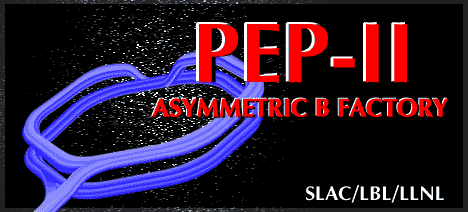 11/11/98 Update
11/11/98 Update
 11/11/98 Update
11/11/98 Update
PEP-II Commissioning Update November 11, 1998
PEP-II commissioning resumed this fall in earnest after the site AC transformer work was successfully completed on October 23. Both rings subsequently turned on very rapidly. During the two month shutdown the High Energy Ring (HER) was not vented. However, extensive vacuum pump work covering most of the circumference was done on the Low Energy Ring (LER). All the vacuum pumps have now been turned on in both rings.
The HER stored a beam within a day. The peak current to date has been 100 mA with an administrative limit. Transverse feedbacks keep the bunches stable. Without transverse feedbacks there are multibunch instabilities in both planes which set in about 10 to 20 mA. The strongest candidate for the instabilities is ions, although some of the data support narrow band impedances. The transverse orbit has been steered to an rms of about 1 mm. The beam lifetime is greater than 20 hours at 10 mA.
The LER stored a beam on October 31. Lattice, chromaticity, steering, and intensity studies have followed. The operational lattice is now the design with correct IR dipoles and ring sextupoles. The chromaticities have been corrected. The orbit has been steered to an rms of about 1.5 mm. There seems to be a systematic horizontal offset of about 1.5 mm due mostly to a small ring circumference error and a systematic vertical offset of about 1 mm due to fields on the LER from the high current cables in the trays. A maximum current of 5.7 mA in a single bunch has been achieved and 22 mA in multibunches (both administrative limits). The beam lifetime at 0.8 mA was 30 minutes in early November and has risen to about 80 minutes with radiation scrubbing. The beam lifetime yesterday at 14 mA was 20 minutes. The wiggler magnet has been turn on briefly.
Yesterday we collided for the first time in November for two shifts. We got the collision axis close by using the shared position monitors 0.7 m from the IP. Next, beam-beam scans of 1 x 1 bunches allowed us to center the beams precisely. The beam-beam horizontal and vertical scans were very clean with the expected "s" shaped curves seen. The beams were easily injected with head-on collisions. The luminosity monitor (Clive Field et al) using gammas from the reaction e+e- goes to e+e-gamma saw a very clean luminosity signal. Other nearby loss monitors also saw luminosity signals. The luminosity values were measured in the luminosity monitor and estimated from calculations given the measured beam sizes and currents. Both gave consistent values. We raised the currents in each bunch until the other beam had a reduced lifetime. We saw various flip-flop effects on the vertical beam sizes during orbit manipulations but they were not studied in detail. We also saw shifted betatron tune lines on the spectrum analyzer for both beams. In the end, we collided single bunches of 1.3 mA positrons and 0.6 mA electrons (the design currents and present beam-beam limits) and obtained a luminosity of 2 to 3 x 10**29/cm**2/sec. We also collided 14 mA of positrons on 7 mA of electrons in 11 bunches with the luminosity monitor signal increasing 11 times to about 3 x 10**30/cm**2/sec. This is about a factor of 20 over the luminosity seen in July. Our present tasks are now to reduce the vertical beams sizes at the IP to increase the single bunch luminosity by a factor of 5 and to increase the number of bunches, now limited in practice by the LER lifetime.
The future plan is to commission both rings until about December 14, resume commissioning for a month starting about January 15, install BaBar from mid-February to late April, and to resume ring commissioning with BaBar by May 1, 1999. Thanks to everyone --- John Seeman 11/11/98
Suggestions to: John Seeman
[PEP-II Commissioning Updates] [PEP-II Home Page] [BABAR Detector Home Page] [SLAC Home Page]
Page owner: achan